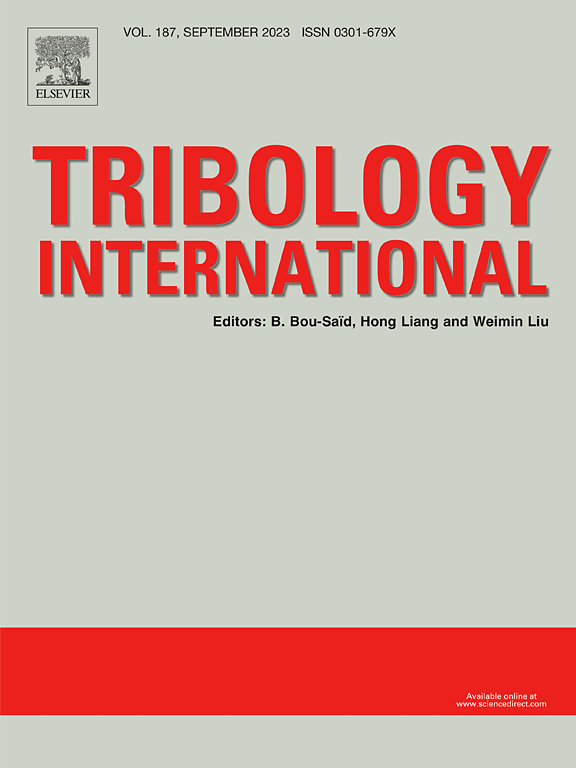直通式迷宫式密封泄漏与动态特性的不确定量化
IF 6.1
1区 工程技术
Q1 ENGINEERING, MECHANICAL
引用次数: 0
摘要
提出了一种基于多项式混沌展开(PCE)的不确定性量化框架,用于评估不确定条件下环形气密封的密封性能和转子动力性能。考虑密封间隙和空腔深度的几何偏差,以及进口压力和进口涡流速度的运行波动,利用该UQ框架对直通式迷宫式密封的泄漏和动态特性进行了不确定性分析和全局敏感性分析。阶收敛分析表明,三阶PCE为研究中密封泄漏和动态特性随机系统的不确定性传播提供了一个足够精确的替代模型。在随机输入的影响下,密封泄漏量的统计平均值与设计值接近,偏差超过10 %的概率达到36.6 %。有效刚度的统计平均值略高于其设计值,在第一腔和密封间隙附近观察到更大的变化。此外,有效阻尼的统计平均值低于设计值,在较低频率处具有较大的标准差,主要来自上游空腔。全局灵敏度分析表明,密封间隙的偏差是影响密封泄漏和有效刚度的主要因素,而进口旋流速度的波动是影响有效阻尼和交叉频率的主要因素。此外,通过详细分析流场和空腔反力相量,探讨了影响密封性能不确定性的主要因素的影响机制,并定量评估了临界随机输入偏差的影响。本文章由计算机程序翻译,如有差异,请以英文原文为准。
Uncertainty quantification on the leakage and dynamic characteristics of a straight-through labyrinth seal
An efficient uncertainty quantification (UQ) framework based on the polynomial chaos expansion (PCE) is developed in this study to assess the sealing capability and rotordynamic performance of annular gas seals under uncertain conditions. Considering geometric deviations in seal clearance and cavity depth, as well as operational fluctuations in inlet pressure and inlet swirl velocity, uncertainty analysis and global sensitivity analysis are conducted on the leakage and dynamic characteristics of a straight-through labyrinth seal using the present UQ framework. The order convergence analysis demonstrates that the third-order PCE provides a sufficiently accurate surrogate model for uncertainty propagation in the stochastic system of seal leakage and dynamic characteristics in this study. Under the influence of stochastic inputs, the statistical mean of seal leakage closely matches the design value, while the probability of a deviation exceeding 10 % reaches 36.6 %. The statistical mean of effective stiffness modestly exceeds its design value, with greater variability observed in the first cavity and near the seal clearances. Additionally, the statistical mean of effective damping falls below the design value and possesses larger standard deviations at lower frequencies, which primarily originate from upstream cavities. Global sensitivity analysis reveals that the deviation in seal clearance is the dominant factor affecting seal leakage and effective stiffness, while the fluctuation in inlet swirl velocity primarily contributes to uncertainties in effective damping and crossover frequency. Furthermore, the influence mechanisms of dominant contributors to the uncertainties in seal performance are explored by analyzing the detailed flow fields and cavity reaction force phasors, and the effects of deviations in critical stochastic inputs are quantitatively assessed.
求助全文
通过发布文献求助,成功后即可免费获取论文全文。
去求助
来源期刊

Tribology International
工程技术-工程:机械
CiteScore
10.10
自引率
16.10%
发文量
627
审稿时长
35 days
期刊介绍:
Tribology is the science of rubbing surfaces and contributes to every facet of our everyday life, from live cell friction to engine lubrication and seismology. As such tribology is truly multidisciplinary and this extraordinary breadth of scientific interest is reflected in the scope of Tribology International.
Tribology International seeks to publish original research papers of the highest scientific quality to provide an archival resource for scientists from all backgrounds. Written contributions are invited reporting experimental and modelling studies both in established areas of tribology and emerging fields. Scientific topics include the physics or chemistry of tribo-surfaces, bio-tribology, surface engineering and materials, contact mechanics, nano-tribology, lubricants and hydrodynamic lubrication.
 求助内容:
求助内容: 应助结果提醒方式:
应助结果提醒方式:


